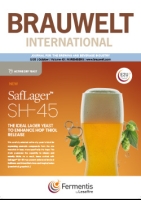The Brewers Association (BA) announced on 30 October an agreement with the United States Department of Agriculture-Agricultural Research Service (USDA-ARS) to fund public hop breeding for the purpose of developing and releasing disease resistant aroma hop cultivars into the public domain, in support of hop growing efforts throughout the US. The trust agreement between the BA and USDA-ARS provides funding for a program located in Washington and Oregon to leverage significant existing academic and operational infrastructure.
The 2017 Hopsteiner Guidelines are almost ready and will soon be available on our homepage www.hopsteiner.com.
Ever since Charles Darwin published his seminal work, “On the Origin of Species by Means of Natural Selection” in 1859, his concept of the survival of the fittest has been a salient metaphor for our understanding of how living organisms evolve. The key to Darwin’s concept is that the selection is “natural,” that is without interference by humans.
Quebec‘s national poet, Gilles Vigneault, once sang, “Mon pays c‘est l‘hiver” (my country is winter). Of course he is correct, because, for most of the year, the Quebecois live in an almost artic terroir where blowing snow and intense cold keep them indoors. During those times, they naturally reach for a heart-warming brew like a Barley Wine or a Triple.
New hypothesis | Many researchers have tried to identify key flavour compounds contributing to the varietal aroma of “flavour hops” imparting very characteristic fruity flavours to finished beers. Until now, certain volatile thiols and monoterpene alcohols have been reported as being possible contributors to hop varietal aromas. In this contribution, a new hypothesis of synergies between volatile thiols and monoterpene alcohols is proposed.
The article summarises parts of the research results which have already been published in BrewingScience (Vol. 69, 11-12, 2016, pp. 85-93).
Both viability and vitality are important parameters for characterisation of yeast physiology. However, under actual brewing conditions, viability and vitality are often unrelated. This presents a fundamental challenge for evaluation of yeast physiology. To address this problem, a new concept for simultaneous evaluation of both viability and vitality is proposed for use in the brewing industry. The following article summarises research results which have already been published in BrewingScience (Vol. 69, 5-6, 2016, pp. 33-41).
“Hops – a pure passion!” This declaration was made by a man who had traveled a great distance to St. Stefan am Walde (Mühlviertel) near the northern border of Austria, in order to attend the meeting of the scientific-technical committee of the International Hop Growers’ Convention (IHGC) which took place from 25th to 29th June 2017. When asked why he is taking part in the four-day congress for hop scientists, US brewer David Grinnell immediately responded with firm conviction: “Because hops are an obsession.” Grinnell is interested in everything about hops, from breeding and cultivation to phytopathology, bacteriology and entomology, as well as hop chemistry, molecular biology and biotechnology research.
On August 28th and 29th RMI Analytics conducted a crop tour of commercial barley fields and malting facilities in Central Alberta in Western Canada.
Hopping Recipe: The base beer (14°P. 6,0 Vol.-% alcohol) was identical for all four samples. The pale ales were dry hopped with pellets type 90 using a different variety for each one. Bravo™ (P90) was used for the base beer in the brewhouse, 70% at boil begin and 30% 20 min. before boil end.
On August 23rd, the estimate for the Hallertau was announced, meaning that crop 2017 estimates for all German hop growing areas have now been submitted.
Interest in hop varieties with distinctive and unique aromas is increasing. In Part 1 of this series of articles, pre-screening brewing trials using the Stage-Gate process in assessment of new Hüll breeding varieties were examined. These trials were limited to dry hopping. Breeding strains showing good results in pre-screening were then tested in large-scale field trials. They were subsequently subjected to a more intense brewing process. Ongoing brewing trials with two breeding strains tested are described in Part 2.


